

BV 141B
The RLM was
not happy with the fuselage section and for the next aircraft it was
completely redesigned, resembling the crew portion of the Fw 189.
Hydraulic failure on the second machine caused it to be heavily damaged
in a landing accident so the third aircraft ended up participating in
the flight trials and was considered a production prototype. In order
to improve its directional stability the fuselage was lengthened and
the wingspan was increased. To improve ground handling the wheel track
was widened as well. In spite of the RLM's misgivings they were forced
to admit that despite its unorthodox appearance the aircraft possessed
extremely docile handling characteristics and fully met the original
specification. An order was placed for five preproduction
aircraft, The BV 141A-01 to 05. The first of these crashed again due to
hydraulic problems. The other four aircraft were completed on schedule
and completed the
official test program in January of 1940. The Test pilots were
generally favorable in their reports however the Luftwaffe's high
command displayed little enthusiasm for the "oddity" and in April of
1940 persuaded the RLM to cancel its plans for large scale
production. The high command's lack of enthusiasm
was based on
its
unorthodox
appearance and in searching for a valid technical reason for rejection
of the machine decided it was marginally underpowered. Dr. Vogt had
foreseen the possibility that more power would be needed and as early
as 1939 had begun a redesign to take they more powerful BMW 801 radial
engine. Designated the BV 141B, the final mock-up was inspected and
approved by the RLM in February of 1940. Less than a year later the
first of five pre-production aircraft flew for the first time. Blohm
and Voss had a firm contract for five aircraft but had taken options on
a further five pre-production machines and ten production variants. The
BV 141B did not share the pleasant handling characteristics of its
predecessor and major modifications were required in many areas.
Completion of the remaining four aircraft was slowed pending the
outcome of modifications to the first aircraft. The BV 141B also
featured an asymmetrical tailplane which had been first tested on one
of the A series aircraft. This was changed to improve the rear gunners
range of fire. The first B series aircraft (the V9)was delivered to the
Luftwaffe for trials in May of 1941 followed by the V10 a month later.
Constant minor failures troubled the evaluation program and when the
forth prototype was delivered for armament trials it was discovered
that the gun ports were too short and the cockpit was filled with
cordite fumes when the guns were fired. Problems continued to plague
the test program and as a result the fifth and last of the prototype,
the V13 wasn't delivered until May of 1943. In the Autumn of 1941 the
V10, was delivered to a squadron for trials under service
conditions instructions were issued that sufficient BV 141's were to be
delivered to form at least one operational squadron on the Eastern
front. These plans were canceled in the Spring of 1942 by the General
Staff as the Fw 189 was fulfilling the tasks for which the BV 141
had been designed. That, the problems encountered during the
test program, the fact that Blohm and Voss's factory space was
needed for Fw 200 production following a bombing raid and the demand
for BMW engines for the Do 217 and Fw 190 production resulted in the
RLM not taking the option on addition aircraft and as a result the BV
141 never saw squadron service.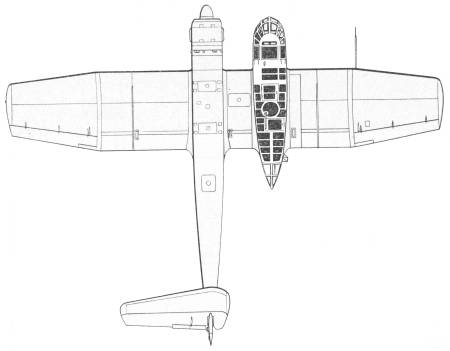
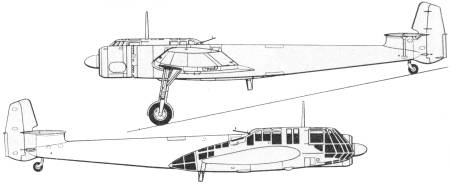
The BV 141 was probably one of the most
unusual
aircraft to take wing during World War II. In 1937 the RLM had issued a
specification to Arado and Focke-Wulf calling for a short range
reconnaissance aircraft capable of fulfilling the light bomber, low
level attack and smokescreen laying roles in an emergency. The RLM
favored the Arado proposal which became the totally unsuccessful Ar
198. Blohm & Voss (then known as Hamburger Flugzeugbau) was not
invited to tender a proposal but their chief designer Dr. Vogt had some
then radical ideas of how to fulfill the RLM's specification and
submitted a private venture proposal, that being the asymmetrical BV
141. The RLM showed little interest in the design, however, Vogt
convinced Ernst Udet, newly appointed chief of the development section
of the RLM, to test fly the design which first flew on February 25,
1938. After his
flight an official contract was placed for three machines.
The Kit
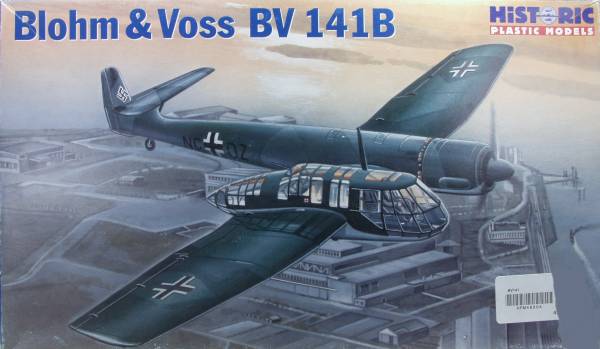
The HiPM kit is the only injection molded kit in 1/48
scale. It comes in a top open two part box with reasonably good artwork
on the top. Inside the box are two plastic bags. One with the clear
parts, decals, film for the photo etched control panel and the
photoetch itself. The other contains the rest of the parts which are
molded in a medium gray plastic. The surface of the plastic is
shiny and smooth. The airframe parts have recessed panel lines. The
lines are very light but uniform and there are some sink marks and
blemishes that will need to be cleaned up. The control surfaces are all
fixed and the fabric detail nicely done. The demarcation lines for the
control surfaces is a bit shallow. The large parts all have a slight
amount of flash while the smaller parts are more heavily flashed and
exhibit some amount of mold misalignment resulting in round parts being
slightly out of round. The sprue attachment points are a bit large so
care will need to be used when removing parts from the sprue. The
cockpit is moderately well detailed with some photoetch parts but due
to the large glassed areas one might want to dress it up even more.
There are some interior views both online and in the references at the
end of the review. There is no engine but if there was little would be
seen due to the engine fan. The wheel wells are closed in but there is
no internal detail there. The tires are not weighted. As is
typical for short run kits there are no alignment pins on parts. The
most problematic issue is no solid method of fastening the wings to the
fuselage to the crew pod. These are all butt joints and some additional
stiffening would be recommended for strength and alignment of the
parts. Altogether there are 96 parts in gray. See photos below.
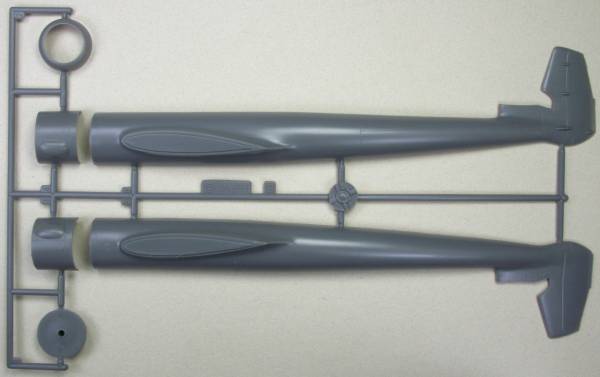
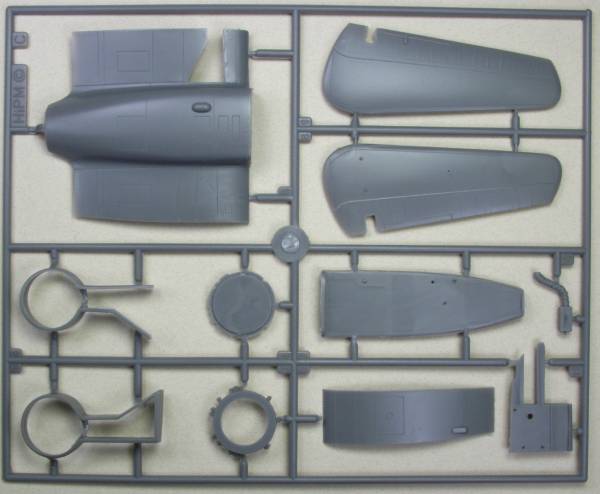
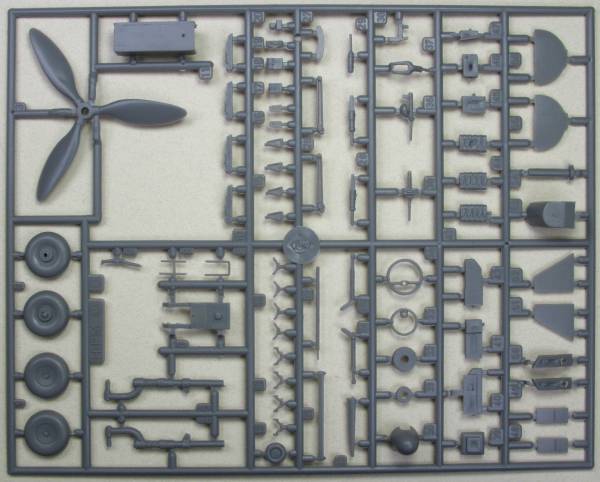
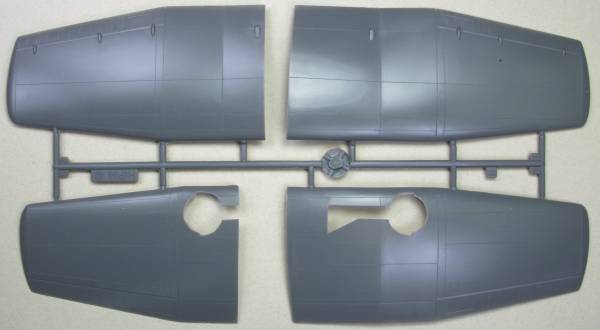
The clear parts set the kit apart from most as due to the large number of glazings in the crew pod HiPM chose to mold the entire section in clear plastic. While not up to contemporary standards on main stream kits the clear parts are relatively clear and should look reasonable with a coat of future. The biggest issue with this arrangement is that there are two windows in the top that will have a seam running through them that will be impossible to polish out. Other clear parts include three hatches that can be posed open or closed and the rotating upper gun position glazing. Altogether there are 6 clear parts for a kit total of 102 plastic parts. See photo below.
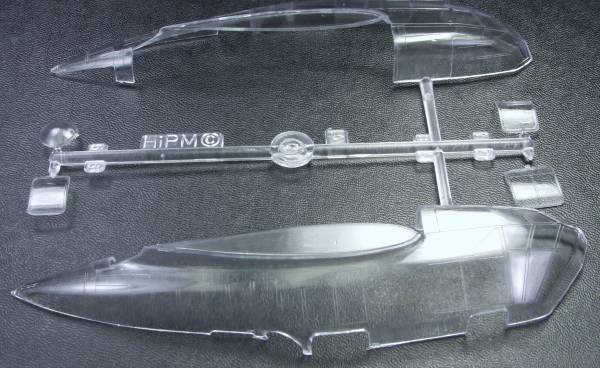
The kit comes with a small fret of photoetch which
consists mainly of cockpit related details, belts, instrument panel,
console, rudder pedals, gun sight and a few other internal items,
torque scissors for the landing gear and a fan for the engine. There is
a film for the instruments and console. Altogether there are 15 PE
parts for a kit total of 117 parts. see photo below.
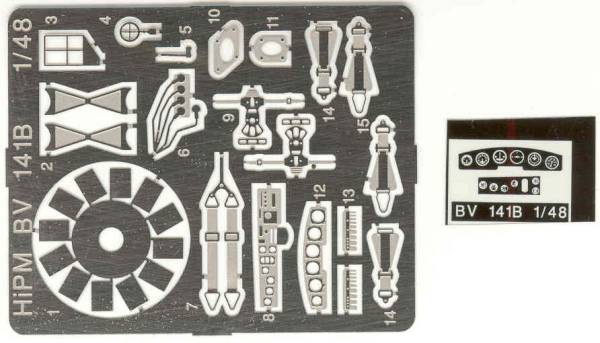
The decals appear thin and well registered and include markings for four of the prototypes with the only difference being the radio call letters. The swastikas are the assemble type. There are no stencils supplied. See below.
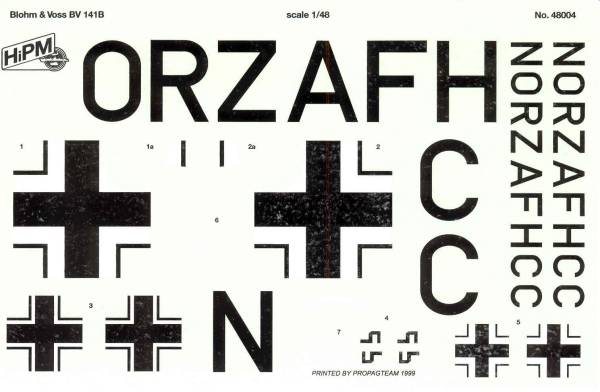
The instructions are printed in a small 12 page booklet. The first page includes a history and specifications in English, page two repeats page one only in Czech along with some basic color information, page three has a parts map, page four though nine are assembly drawings, pages ten through twelve cover painting interior and exterior and markings.
After Market Goodies
The only after market item I am aware of for this kit are window masks from Black Magic [CEBM48359]. You might want to consider getting two sets of these and using one set on the inside.
Conclusions
This kit is typical
of many short run kits and in many ways is much better than many. There
are some issues with the butt joints on all the wing to fuselage to
crew nacelle that need strengthening and dealing with the all clear
crew nacelle and seams in windows may be problematic. Reviews seem to
be mixed as some reviewers relate having all sorts of problems an
others don't but that may be related to skill levels. The only other
kit in 1/48 that has been released is an old Karo-As vacuform kit. A
description of it can be found here.
Links to kit build or reviews
A review can be found here and builds here, here and here.
References
Blohm & Voss BV 141 by David Myhra
Updated 1/26/08